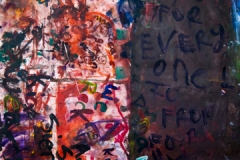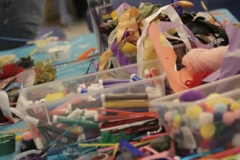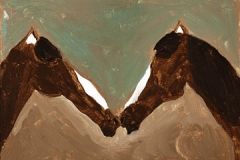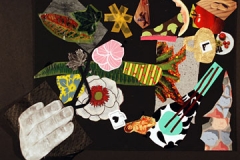Benjamin Davis Brockman, “Art Heals”
 by Benjamin Davis Brockman
by Benjamin Davis Brockman
April 1, 2012
Why is what artists do important?
It’s a question I frequently encounter as an artist and, and I think it’s particularly troublesome issue for many in the studio arts because the work we do, our practice, can often be very solemn and narcissistic. Artists seldom think of themselves this way and usually consider their role as crucial to society as the service a doctor or lawyer provides. Why is it then that a doctor is never asked directly why what he does is important, but people in the arts and other creative fields are plagued by the question?
As arts programs in high schools and colleges across the country are cut to accommodate training in “practical” fields, it becomes increasingly important that an artist be able talk about the value of the work he or she creates. I still haven’t found an articulate the feelings I have about the importance of art, but I have seen the practice of creative expression change lives in a very real and tangible ways, such as the work Esther Callahan does on a daily basis.
Callahan is the Program Coordinator for Free Arts Minnesota—a non-profit organization which places volunteer art mentors in youth shelters and treatment facilities in the greater Twin Cities. I caught up with her to talk about the healing properties of arts and the remarkable influence a creative mentor can play in the life of an at-risk child.
The Fiddleback: Can you tell me a bit about how Free Arts came about?
Esther Callahan: Free Arts was formed in 1977, in California, by Art Therapist Elda Unger and Carolyn Sargent, a woman who, as a child, used art to emerge from the sadness and isolation of hearing loss. They wanted to provide positive outlets for children. In 1997, the Junior League of Minneapolis came along and helped start Free Arts Minnesota in serving children in residential treatment centers, battered women’s shelters, and therapeutic preschools based on the theory that for abused children, art and positive adult relationships are not a luxury but a necessity.
The Fiddleback: How did you come to be involved with Free Arts?
EC: I was first introduced to Free Arts Minnesota through a friend of mine who moved here from Utah. She wanted to volunteer and found Free Arts. I was moved by all the stories she told about her experiences being an art mentor and it encouraged me to check them out. When I did, I fell in love…with the organization, the weekly mentor program and the children we serve. I have been a mentor for six years and only love it more and more each year. I was lucky to have had an opportunity to turn my passion into a career starting as Volunteer Coordinator through Americorps VISTA and then be hired on as permanent staff as Program Coordinator.
The Fiddleback: The slogan for Free Arts is Art Heals. Can you describe what this means? What is it about art that helps people in duress? In other words what do you hope the effect of the program will be on a child in both the long and short term?
EC: We all are healed by art on a daily basis, whether we know it or not. It might be the scarf you are wearing that brings you comfort on a cold day. It may be the design of the keyboard you are using that brings you healing from carpal tunnel; It may be the simple doodle that you drew during a meeting to release the pent up tension you have. We know that the creative process is a way for children to renew and enhance their sense of self-confidence and, through the healing powers of art, illuminate a reason to survive the adversities they face.
The Fiddleback: What do you see as the primary role of a mentor?
EC: The role of a Free Arts mentor is to be a wise and trusted friend and guide—a caring, responsible adult and a positive role model for the children we serve.
The Fiddleback: What is the reach of Free Arts MN, and how it has grown since inception?
EC: The communities from which the youth in our programs are drawn are some of the most diverse and economically challenged neighborhoods in the Twin Cities. The ethnic makeup of those served by Free Arts programs is 60% African American, 22% Caucasian, 10% Asian, 4% Hispanic, 3% multiple-race, and 1% American Indian. Adolescent participants now comprise over 25% of the youth we serve.
Since inception in 1997, we are still the only organization in Minnesota that specifically directs the healing effects of the arts to youth living in treatment centers, shelters and special circumstance educational environments on an ongoing basis. While our work began with partner agencies like Harriet Tubman Family Alliance and St. Joseph’s Home for Children, we went from 13 to 30 agency partners in 2011 and from 2,000 children served per year to serving over 4,000 children per year.
A study by the University of Minnesota and Wilder Research […] concluded that for every dollar spent on effective mentoring programs Minnesota taxpayers can expect a return of $2.72. These are dollars saved through improved school attendance and performance, reduced truancy, improved health outcomes, reduced juvenile and adult crime, and reduced need for social services.
The Fiddleback: Is Free Arts a national institution? Do other states have programs like Free Arts?
EC: There are three other Free Arts Affiliates in Los Angeles, New York City, and Phoenix. As far as Free Arts being a national institution, I don’t think we can go so far as to say that…yet!
——–
Visit FreeArtsMinnesota.org for more information.



